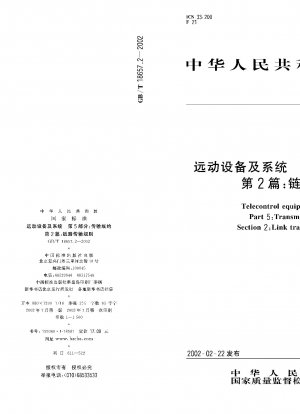GB/T 18657.2-2002
Telecontrol equipment and systems Part 5: Transmission protocols Section 2: Limk transmission procedures (English Version)
- Standard No.
- GB/T 18657.2-2002
- Language
- Chinese, Available in English version
- Release Date
- 2002
- Published By
- General Administration of Quality Supervision, Inspection and Quarantine of the People‘s Republic of China
- Latest
- GB/T 18657.2-2002
- Scope
- This standard is applicable to telecontrol equipment and systems with bit-serial data transmission for the monitoring and control of geographically widely distributed processes. The defined link process is strictly limited to the packet transmission sequence whose size of window V1 is 1. This means that the link layer of the initiating station (the station that initiated the message transmission) can only receive a new message transmission request after a previously received message transmission request has been successfully completed or ended with an error indication. Link transmission rules apply to balanced and unbalanced transmissions in telecontrol systems with half-duplex or full-duplex channels. The standard transmission process defined in this standard is applicable to the point-to-point, multiple point-to-point, multipoint star, multipoint collinear and multipoint ring configurations described in IEC 60870-1-1. The data transmission function in these systems consists of three types of basic link transmission services, namely: 1) Send/No Reply (SEND/NO REPLY) 2) Send/Confirm (SEND/cONFIRM) 3) Request/Response (REQUEST /RESPOND) The two services send/acknowledge and request/response consist of a sequence of inseparable dialog elements between a requesting station and a responding station. The protocol defined in this standard can only receive and process one link transmission service at the same time in each direction of the two-way communication system. Each transfer service shall have completed successfully or reported errors before the next transfer service is started. This means that the window size of continuous group transmission is 1, and the error recovery of sending/acknowledging and request/response transmission services adopts the stop-wait method of automatic repeat request (ARQ). In a point-to-point configuration of a full-duplex channel, the defined protocol supports a balanced transmission process, that is, transmission services are performed simultaneously in both directions of the communication link. This enables the sub-station to report sudden (spontaneous) events to the main station (control station) without the need for the main station to inquire when an event occurs, thereby reducing the reporting delay and realizing faster data collection. However, the use of full-duplex communication channels for each substation will result in increased equipment costs.
GB/T 18657.2-2002 history
- 2002 GB/T 18657.2-2002 Telecontrol equipment and systems Part 5: Transmission protocols Section 2: Limk transmission procedures

GB/T 18657.2-2002 -All Parts
GB/T 18657.1-2002 Telecontrol equipment and systems Part 5: Transmission protocols Section 1: Transmission frame formats
GB/T 18657.2-2002 Telecontrol equipment and systems Part 5: Transmission protocols Section 2: Limk transmission procedures
GB/T 18657.3-2002 Telecontrol equipment and systems Part 5: Transmission protocols Section 3: General structure of application data
GB/T 18657.4-2002 Telecontrol equipment and systems Part 5: Transmission protocols Section 4: Definition and coding of application information elements
GB/T 18657.5-2002 Telecontrol equipment and systems Part 5: Transmission protocols Section 5: Basic application functions